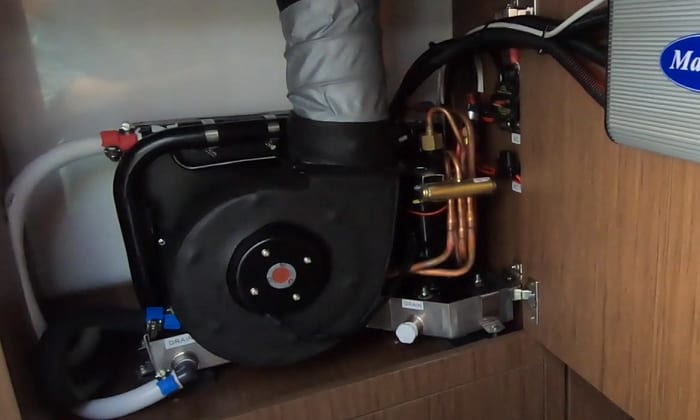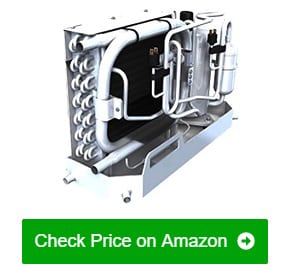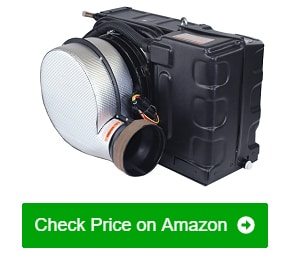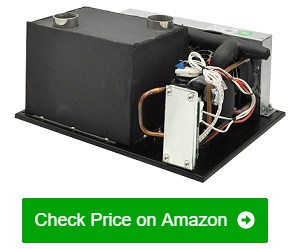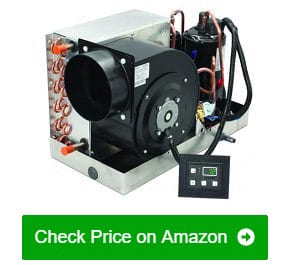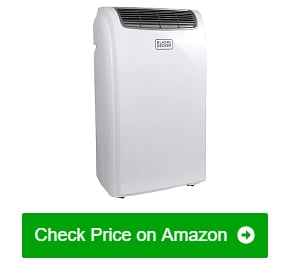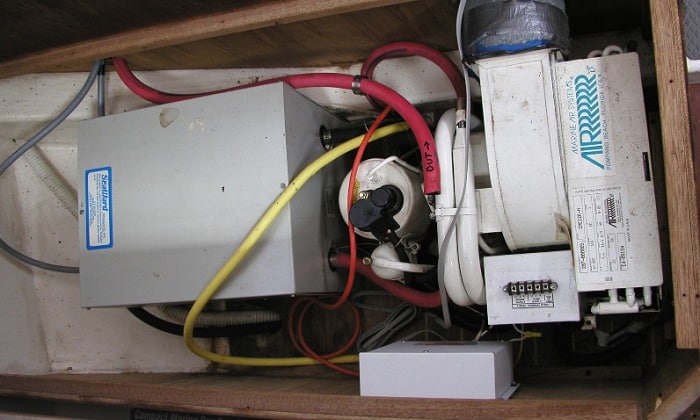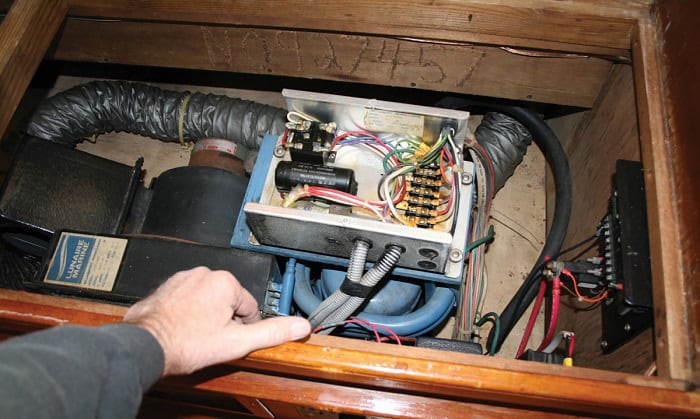Having the best marine air conditioner is beneficial for the entire boat and the people on it. The even temperature movement from any boat AC unit and other self-contained units of a marine AC influence boating results.
Getting the right boat AC system starts with knowing the answer to, “How do you size a marine air conditioner?” Here are other essential features, factors, and FAQs about marine air conditioning systems for your reference:
- Boat Sizing and Layout – These are important when choosing the top-rated marine air conditioners or specific portable boat air conditioner. Decide wisely which marine air conditioner or portable marine air conditioner to buy. Measure the square area you like to get cooled to know the load factor. Include insulations, sunlight exposure, windows, height, and other factors for a large or small boat air conditioner.
- These refrigeration factors help determine the desirable British Thermal Units (BTUs) or power draw for the entire boat, which influences the needed cooling power of the entire boat hatch from your energy-efficient marine air conditioners.
- Ease of Installation: This relates to the practical cost of installing your boat hatch air conditioner. The easier you install it, the better to plug, play, and relocate like a portable AC for boat does.
- Installation for a portable boat AC, a 12 volt boat air conditioner, or a marine air conditioner 16,000 BTU varies. They’ll likely need specific wiring, plumbing, ducting, and location aspects that may be handy, mild, or complex to install.
- Mount your marine air conditioner units properly for good refrigeration cycle or return air to and from the cooling units. Ensure the marine air conditioners have proper ducting, discharge options, and enough space to ease their maintenance servicing.
- Power Supply: All marine air conditioners run on an alternating current or AC power source. They range from a 12v marine air conditioner to a larger 230-volt cooling performance with 3-phase compressors.
Check the manufacturer’s specifications of a marine air conditioner brand for recommended amperage, wiring, and circuit breaker sizes.
Read these reviews to get your most efficient marine air conditioner.
- Easy to install
- Low start-up current
- Best works with boats and yachts
- Power-saving
- Portable and lightweight
- Ideal for small rooms and spaces
Table of Contents
Top 5 Marine Air Conditioner Reviews
1. Webasto 5011396A Air Conditioner Retrofit
Among all the Webasto marine air conditioners (ACs), this self-contained AC retrofit unit is the first bestseller. Boaters love this sailboat air conditioner model that comes as a platinum series with a chiller unit for optimum performance.
The 5011396A marine air conditioning system has a cooling output of 115 volts/60Hz producing 10,000 BTU. It features a reverse cycle heat marine AC with quiet operation and a robust design that is solidly built and economical.
This self contained marine AC unit works best as a new installation or replacement and upgrade of an entire unit. The square-sized kit has a compressor compartment, condenser, evaporator, remote thermostat, and controller for a quiet operation.
I love the AC kit’s performance among big air conditioners with superior velocity blowers. The velocity blowers are durably built, comes with instructions, and complete with product information and materials for solid cooling results.
It’s a digitally and remotely programmable thermostat providing ease of operations, monitoring, and noise reduction. I can attest that these boat air systems work as one of the top-tier marine air conditioners in the market.
- Low fuel consumption/maintenance, and solid cooling results
- Well-designed and durable construction for a hassle-free installation
- Affordable and best marine AC system for a quieter operation
- Comes with a chiller unit for an optimized performance
- Excellent velocity rotatable blowers and remote thermostat control
- The square-sized air conditioner system may be difficult to retrofit
2. MarinAire Marine AC and Heat Pump
Another bestseller on our review is a compact size marine air conditioner and heat pump manufactured by MarinAire. It is really easy to install and provides outstanding cooling and quieter operation like a portable marine air conditioning unit.
I‘ve been using this 110-120 volt and 60-hertz contained marine air conditioner for over 2 years. This Integra model is easy-to-install with built in pressure gauges for better operations using its D smart control system. The digital control features help the configuration and setup of the remote temperature sensor. It is a very good small marine air conditioner unit that works with limited cabin enclosures and tiny boat spaces.
The marine AC unit has a low start-up current or low energy consumption even at higher cooling temperatures. The high-velocity rotatable blower of this boat air system works well when adjusted for any 360-degree cooling position. It comes with a compressor sound cover for noise reduction, stainless steel drain pan, and an environment-friendly R410A refrigerant. Hence, it is great as a 16000 BTU self contained marine air conditioner and heat pump 115v60 system.
- Self-contained marine air conditioner and heat pump with low start-up current
- Easy to install and monitor with rotatable blower and built in pressure gauges
- D-smart control system for better performance monitoring
- Compactly built with stainless steel drain pan and compressor sound cover
- Best works with boats and yachts
- Limited for use on boats and yachts and not designed for vehicles and home use
3. CAMPELIFY 1910E-AC Compact Air Conditioning
Check this 12v marine air conditioner review for a compact air conditioning system with a mild cooling capacity you’ll like. It comes with a DC mini-rotary compressor that is ideal for boats, camper vans, vehicle chiller’s, and refrigeration cooling systems.
This portable AC unit has a versatile, compact cycle efficiency and lightweight design for indoor and outdoor uses. It is dubbed the top-rated boat air conditioning system with 450 watts/1,535 BTU cooling power for boats and vehicles.
The compact refrigeration unit comprises of a driver board, condenser, mini-rotary compressor, evaporator, capillary, controller, etc. Its highly-tight direct refrigeration cooling unit features a miniature DC rotary compressor for high performance and vibration cushioning.
I love how this DC air conditioner uses vapor compression technology to chill the air in my boat cabin. Add its microchannel condenser, 1.9-liter compressor, and a 134A refrigerant that removes the heat and circulates chilled air, this is the smartest among boat air handlers I’ve tried for efficient spot cooling in small spaces. It uses a corded electric power source that can be a grid or battery.
- Portable and lightweight AC cycle cooling efficiency for indoor and outdoor uses
- Easy to set up low-cost air handler than most marine air conditioners
- Ideal for spot cooling small rooms and spaces
- Uses vapor compression technology for chilled air of any enclosed spaces.
- Power-saving and works with most 12V batteries, grid, or solar
- To cool larger rooms, it needs to run at full blast for optimal cooling power
4. Dometic 207500310 EnviroComfort Retrofit
Enjoy your boating seasons with this “EnviroCimfort (ECD) Dometic marine air conditioner that packs plumbing and air movement essentials. This retrofit kit is a handy air filter system for mid-sized boats and marine vessel cabins or enclosures.
The Dometic 12,000 BTU marine air conditioner is a dependable upgrade with innovative design, power, and affordable features. I like how it makes an environmentally friendly retrofit solution with useful plumbing and air movement components. This Dometic model is effective in distributing hot air to cool up my boat including the engine room whole year-round. It also comes with an electric box for easy operations, which I enjoyed using since the day I bought it.
Ensure your boat is cool all season with these self contained units of ECD AC kit. It is accompanied by an R-410A refrigerant for ecologically fit cooling performance you’ll surely like. When you purchase it, you will be given a 6 to 12 months of labor and parts warranty. Moreover, you wi;l appreciate that it is a lot more affordable than retrofitting old BTU H self-contained marine ACs.
- Affordable high-capacity marine AC for the best value of money
- Easy-to-install BTU H self-contained marine air conditioning kit
- Power-saving stellar reverse cycle heating and air filter system for mid-sized sailboats and larger boats
- Effective air distribution for boat enclosures any season of the year
- Environmentally-friendly retrofit kit with plumbing and air movement solutions
- Needs a sound shield for quieter operation
5. BLACK+DECKER BPACT10WT Portable AC
The final product on our list is a white BLACK+DECKER portable air conditioner with remote control. This corded electric-powered AC is a solidly powerful cooling and dehumidifying unit that can work well during emergencies.
It provides an unrivaled air conditioning output g to beat the heat. This versatile cooling unit can serve as a main and backup AC unit for midsize cabins while at sea. It has an optimal cooling output at about 10,000 BTU ASHRAE exhaust system. I love its easy-plug-and-play features: a window adaptor, main power cord, and other useful components for each trip.
I bought two units of these small compact AC systems, which helped me complete a great sailboating escapade. The sudden temperature issues while using them as a cooler and dehumidifier are within control. They can be used alternately as primary and secondary units for over 30 days sailboating period. Their environment-friendly R410A refrigerants and LED control panels made them safer and fully remote-controlled.
- Easy to install and assemble portable AC and dehumidifying system
- Quick remote control access and LED control panel for ease of use
- Affordable boat air handler with strong cooling output that beats the heat
- Best to work as a primary and secondary AC unit for all sizes of enclosures
- Power saving with 24-hour timer, sleep mode, and 3-fan level control
- Its cooling strength causes bothersome noise
Factors To Consider When Choosing Marine Air Conditioners
Understanding how the marine air conditioner works needs a basic awareness of the brands available in the market. The brands in these reviews offer the AC types and components you need to operate them in your boat.
All three main types and functionalities for an effective refrigerant system are simplified below for your guide. Remember that they all have AC components comprising of a compressor, condenser, and evaporator to ease your needed air movement.
These components cool the air circulation with the help of a refrigerant flow, push the airflow cooling process, and transfer it to an evaporator component and then to the air handlers.
The distribution process also includes fans and air handlers to get cooled or chilled air into your boat cabin. You need to know these factors to judge affordable brands, heavy-duty types, among other essentials for quality boat air circulation.
What Are the Three Main Types of Boat Air Conditioning Systems
Many variants of air conditioning kits are offered in the market but boat lovers consider only a few of them. Choose among these three high-quality marine air conditioner types based on your boat size and layout:
- Self Contained Direct Expansion Systems or DX Type AC systems are loved by most boaters for their budget efficiency features. What’s more lovable about these boat AC units is that they are easy-to-install, maintain, move, and restore. They usually work for small-sized to mid-sized boat or marine vessels within about 40 feet vessel length. But they produce a bit of.
- Remote Systems or Split Gas Types are widely used in mid-sized and large marine vessels like yachts and sailboats. Split gas AC units feature a centralized condenser connected by a copper wire to a number of air coolers. Aside from being For their quieter and more space-saving perks, however, you will need to shell out a bit more money.
- Tempered Water Systems or Chilled Water Types are your best option when needing versatile boat AC systems. These systems use a refrigerant in cooling the desired areas of your boat enclosure. But you need to customize an adequate housing for its pipes, low pressure gauges, ducting, and air handlers.
Benefits and Drawbacks of a Marine Ac Unit
Go over the advantages and disadvantages to clear any second thoughts about getting your best choice from this series of reviews
Advantages
- Has hybrid refrigerant system combining cooler, dehumidifier, and heater functions
- Uses environment-friendly refrigerants for chilled water AC systems and low power consumption
- Packs safety, comfort, and versatility that you may not have enjoyed before
- Makes a cooling difference that beats the heat even at the highest temperatures
- Specially designed AC kits to cool or heat specific areas of your boat
- Portable AC units requiring effortless installation, movement, and maintenance
- Power saving AC models with useful components to extend for longer uses
- Fully remote AC system with LED monitors for less space and quieter operations
- Effective single or self contained AC unit that can cool multiple boat enclosures
- Manual or auto-controlled temperature levels for effective airflow and flexible cooling of multiple areas
Disadvantages
- Expensive models like split gas types having special components and systems
- Larger AC systems can create bothersome noise while cooling wider boat areas
- AC units with larger compressors and cooling, and air handlers consume high amounts of energy from a boat’s battery
Use these marine AC benefits and drawbacks to choose the right one for the layout and size of your boat.
General Care and Maintenance Tips
Follow the essential factors in getting the right ones and know how to maintain and care for them effectively. Taking into consideration the ease of installation, AC efficiency, boat layout and size, and quieter operation are some key aspects. Include as well these general tips for proper care and maintenance:
- Safe and Comfort of Use: Any AC system onboard a vessel is aimed towards cooler air for each boat area. Maintain the AC unit to provide desired temperature levels for the safety and comfort of the people aboard the boat. Include in the preventive checks and care servicing the condenser, compressor, evaporator, air filter, air handlers, and cooling components.
- Quality of Material and Boat Equipment: Amidst extremely hot and humid weather, the soundness of your boating emanates from regular maintenance activities. Ensure preventive servicing is done to prevent rust and corrosion from endangering the quality of the boat and equipment.
- Discharge, Ducting, and Wye Provisions: Ensure that there is sufficient space around the unit to do the maintenance servicing. Remove the unit if necessary, especially the split gas types to include visual checks of the surrounding containment.
These maintenance and care factors are within the functionalities of all the AC brands in this series of reviews. Performing these basic care and maintenance servicing will help prevent enery-consumption and smooth operation issues.
How Many Watts Does A Marine Air Conditioner Use
Adding a boat AC onboard may require a generator set aside from the usual battery-powered supply. Ensure around 120-volts/2500-watts AC power to enjoy a 10,000 BTU AC unit, among other electric-powered appliances.
While being docked, a 5,000 BTU AC draws around 5 amperes/1,250 watts with 120-volt power. Generator sets could be an option to supply consistent power to you boat and AC equipment. Inverter-type power sets can also allow you the use electronic equipment, computers, and power tools instead of noisy generators.
How Long Do Marine Air Conditioners Last
These marine AC systems can serve for about 10 to 15 or more years when properly cared for. Various factors affect the life expectancy of a boat air conditioning system. AC models that complete the manufacturer’s recommended repairs, regular checks, and preventive measures can reach about 20 years. Always refer to the manufacturer’s product specifications and care sheet for the appropriate servicing and use.
How Do You Maintain A Marine Air Conditioner
Do the general maintenance of the boat airconditioning system in a regular and timely manner. Cleaning and declogging dirty air filters ease out the refrigeration system by freeing the airflow passage for the system’s efficiency.
Do the same cleaning of the interior and outdoor AC systems to visually check, clear debris, and rinse condenser coils. Ensure to check the thermostat, clean filters, declog drain lines, and switch-off humidifiers when not in use. Use a small brush, a vacuum, and blowers to dry wet parts before the next operation. Test the drain line by pouring some water for declogging and schedule the next maintenance or tune-up.
How Do You Size A Marine Air Conditioner
The basic tip in sizing your boat air conditioning system is to get the area of the room you need cooling. Get adequate room cooling by multiplying 25 BTU to the total area in square feet. So, for a 200 square feet area dimension, you would need about 5,000 BTU airconditioning systems. Divide the total BTU, say 12,000 by 12,000 to get the 1-ton capability for the new cooling system.
The larger the area to get cooled, the higher capacity and pump connectivity to get on your boat. The use of a pump manifold and pump relay also helps your boat AC unit using a common heat pump.
Ensure to get the needed cooling for the boat room considering various weather conditions and factors mentioned in these reviews. Correctly measure your marine vessel’s AC tonnage to get the heat you need to remove, especially when used for 24 hours.
Conclusion
The essential factors, AC types, and FAQs for the best marine air conditioner units are in these reviews. These top portable air conditioner for boat units and other marine vessels are your premium choices.
Whether a large or a small AC unit for boats or enclosures, they make spaces efficiently cool, providing efficient trips despite fluctuating temperatures or heat levels. Choose from the largest to the smallest boat air conditioner from this unbiased guide. Decide on getting a marine air conditioner 16,000 BTU cooling units or other premium choices that boat owners love.

“My intention from the first day establishing Boating Basics Online is to provide as much help as possible for boaters who want to experience a first safe and convenient trip. So feel free to join us and share your beautiful journeys to the sea!”

